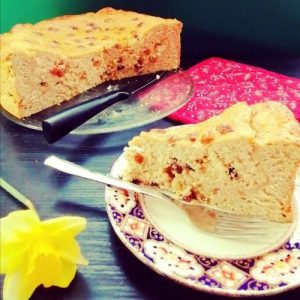Traditional Easter Pasca Cheesecake
Pasca is the traditional Romanian Easter cheesecake specific to this religious holiday only. A culinary delight for a special occasion!
Ingredients
Pasca Dough
- 600 g white flour plain or strong bread
- 120 g sugar coconut
- 125 ml tepid water
- 10 g dried yeast
- 125 ml tepid milk
- 3 eggs plus 1 for coating before baking
- 60 g butter melted and cooled
- 1 pcs orange/lemon zest organic
- 1 tsp vanilla essence
- 1 tsp rock/sea salt
For the filling
- 1 kg cheese cottage, ricotta or homemade, drained
- 150 g raisins
- 3 pcs eggs
- 70 g semolina use gradually
- 4 tbsp coconut sugar
- 1 tsp rum essence
- 1 tbsp orange zest organic
- ¼ tsp salt
Instructions
Pasca Dough
- For the starter dough, mix the sugar with yeast, a little sieved flour and tepid water. Allow 10-15 min to activate the yeast, preferably in a warm place.
- Once the yeast has activated and started making tiny bubbles, add the butter (melted and cooled previously), milk, eggs, organic orange zest. Mix well.
- Add the salt and the rest of the sieved flour and start kneading. Depending on the type of flour used, the exact quantity needed might vary. Add it gradually while kneading either with a standing mixer or using your hands.
- When the dough makes little air pockets as you fold it, you will know it has enough flour.
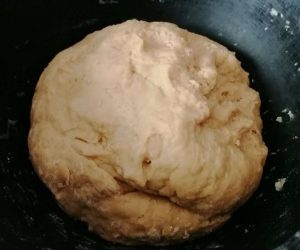
- At this point, heat the oven to 50°C/122°, then turn it off and place the bowl on the middle rack to let the dough rest for at least 30 minutes. Typically, it has rested enough when the volume has doubled.
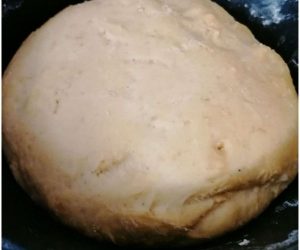
- Before the last stage of preparation, preheat the oven to 160°C/320°F.
- When the resting time is up, use a part of the dough for the braided wall and keep a larger amount for the base.
- Depending on how many threads you want to use, roll thin ones and braid them. I only used three and rolled them up as thin as I could.
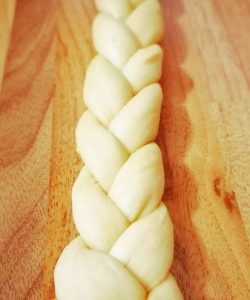
- The rest of the dough will go on the base of the baking mould. Use a rolling pin to shape it in a 1-1.5 cm high round form; even if you press the dough, it will still fluff up once in the oven.
- Prepare your baking mould. I used a 24 cm diameter loose base baking tray with parchment paper fit on the base and well-oiled walls.
- Place the base dough in the tray and the braided dough vertically on the wall. You might need extra hands for this step, as the dough is elastic and will tend to fall and shrink.
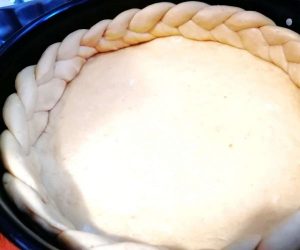
- As the helper holds the braided dough in place, add the cheese filling in the middle and spread it evenly using a large spatula.
- Separately, beat an egg with a teaspoon of sugar and brush the entire surface of your pasca.
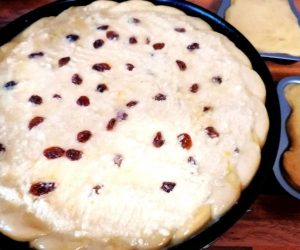
- Reduce the oven's temperature to 150°C/302°F and place the baking mould on the middle rack (position 3).
- Bake for 30-40 minutes or until pasca turns golden brown. If it burns too early, you might need to cover it with another tray.
- Do not open the oven's door during the first 20 minutes. After that, you can turn the pasca to allow even baking.
- Perform the toothpick test to check if the cake is baked thoroughly and cool on a rack before removing it from the tray.
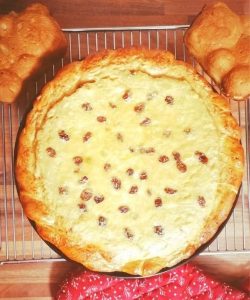
Cheese Filling
- In a large bowl, mix the well-drained cheese with sugar, raisins, eggs, semolina, essences and orange zest, plus a pinch of salt to enhance the taste.
- The composition has to be similar to a regular cheesecake. If it is too soft, you can add more semolina. If it is too hard, it might require another egg.
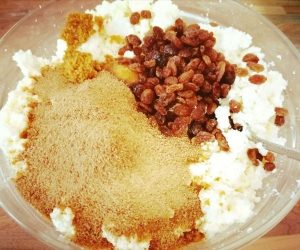
Notes
Pasca can be kept in the fridge for up to five days, preferably in a cake container. I never tried to freeze it, and I don't recommend it, as the cheese might go crumbly or too wet when defrosted. After all, this is a cake we make once a year, for an exceptional occasion, so I don't see the point in preserving it.
Before serving, bring to room temperature.
Enjoy!
